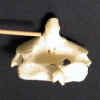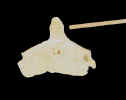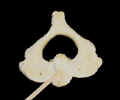


 Posterior view
Posterior view

 Superior view
Superior view
The odontoid process (dens) was the body of the atlas during embryonic development, however, it breaks away. The dens fuses to the body of the axis during fetal development or early childhood. It then serves as a pivot point for the atlas (C1). This joint is sometimes described as a mortise and tenon joint, the only such joint in the body. It allows for rotation. We find an oval facet on the anterior surface of the odontoid process. This is where articulation with the anterior arch of the atlas occurs. The alar ligaments attach the odontoid process to the medial surfaces of the occipital condyles, and they prevent excessive rotation of the atlas and head relative to the axis. Another ligament, the transverse ligament of the atlas, runs posterior to the odontoid process and this ligament holds the dens in position. See the write-up about the axis for details of problems that may arise during injuries involving the atlantoaxial joint. The odontoid process gets its name from its resemblance to a tooth.
COPYRIGHT
2007 by William C. Johnson II
ALL RIGHTS RESERVED!